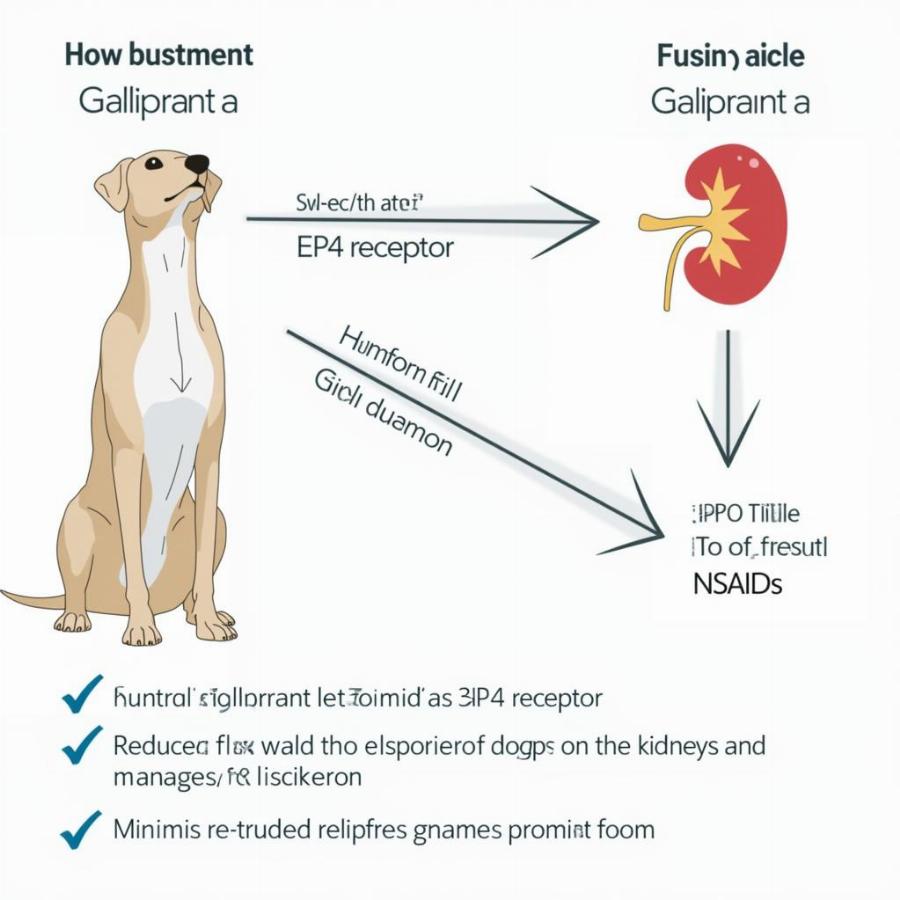The phrase “Galliprant killed my dog” can be alarming for pet owners considering this medication for their canine companions. This article will delve into the facts surrounding Galliprant, its potential side effects, and address concerns about its safety. We’ll explore what the research says, discuss alternative pain management options, and empower you to make informed decisions about your dog’s health.
Understanding Galliprant and its Purpose
Galliprant is a non-steroidal anti-inflammatory drug (NSAID) specifically designed for dogs to manage pain and inflammation associated with osteoarthritis. It works by inhibiting the prostaglandin EP4 receptor, which plays a crucial role in the inflammatory process. This targeted action is thought to reduce the risk of some of the common side effects associated with traditional NSAIDs.
How Galliprant Works to Manage Pain
Unlike other NSAIDs that inhibit both COX-1 and COX-2 enzymes, potentially leading to gastrointestinal and kidney issues, Galliprant selectively targets the EP4 receptor. This mechanism is believed to offer a safer approach to pain management, particularly for dogs with pre-existing health conditions.
 Galliprant Mechanism of Action
Galliprant Mechanism of Action
Potential Side Effects of Galliprant
While generally considered safe, Galliprant, like any medication, can have potential side effects. These can include vomiting, diarrhea, loss of appetite, lethargy, and increased thirst. It’s crucial to remember that these side effects are typically mild and transient.
Recognizing and Addressing Side Effects
If your dog experiences any adverse reactions after starting Galliprant, it’s essential to consult your veterinarian immediately. They can assess the situation, determine if the medication is the cause, and adjust the dosage or explore alternative treatment options if necessary.
Is Galliprant Actually Dangerous for Dogs?
The claim that “Galliprant killed my dog” is often based on anecdotal evidence and doesn’t necessarily reflect a causal relationship. While some dogs may experience severe adverse reactions to any medication, including Galliprant, these cases are rare. It’s important to distinguish between correlation and causation.
The Importance of Veterinary Guidance
Before starting your dog on any medication, including Galliprant, a thorough veterinary examination is crucial. This allows your veterinarian to assess your dog’s overall health, identify any pre-existing conditions, and determine the appropriate dosage and treatment plan.
Exploring Alternative Pain Management Options
If you’re concerned about using Galliprant, several alternative pain management options exist for dogs with osteoarthritis. These can include other NSAIDs, pain relievers like Gabapentin, physical therapy, acupuncture, and weight management.
Finding the Right Approach for Your Dog
Choosing the best pain management strategy for your dog requires careful consideration of their individual needs and health status. Your veterinarian can guide you through the available options and help you make an informed decision.
Conclusion
While the phrase “Galliprant killed my dog” raises valid concerns, it’s crucial to approach such claims with a critical eye. Galliprant, when prescribed and administered correctly, can be a valuable tool for managing pain and inflammation in dogs. Open communication with your veterinarian, careful monitoring for side effects, and exploring alternative options if needed are key to ensuring your dog’s well-being. Remember, a thorough veterinary evaluation is essential before starting any new medication.
FAQ
-
What are the most common side effects of Galliprant?
- The most common side effects are vomiting, diarrhea, loss of appetite, and lethargy.
-
How long does it take for Galliprant to start working?
- Galliprant usually begins to take effect within a few days.
-
Can Galliprant be used with other medications?
- Always consult your veterinarian before combining Galliprant with other medications.
-
What should I do if my dog experiences side effects from Galliprant?
- Contact your veterinarian immediately if your dog experiences any adverse reactions.
-
Are there any natural alternatives to Galliprant?
- Some natural options include supplements like glucosamine and chondroitin, as well as physical therapy and acupuncture.
-
Is Galliprant safe for long-term use?
- With proper veterinary supervision and monitoring, Galliprant can be used long-term.
-
How much does Galliprant cost?
- The cost varies depending on your dog’s size and the dosage prescribed.
Beaut Dogs is your trusted source for comprehensive information on all aspects of dog ownership. For personalized advice and support regarding your dog’s health, please contact us at Email: [email protected]. Beaut Dogs is committed to providing reliable and expert guidance to help you care for your canine companion. We’re here to help you navigate the world of canine care and ensure your furry friend lives a happy and healthy life. Visit https://beautdogs.com for more information.